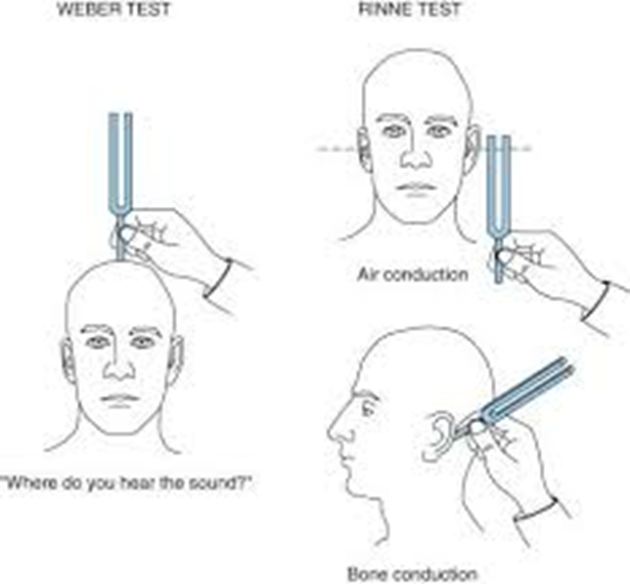A patient is diagnosed with left ear unilateral sensorineural hearing loss. During the performance of the Weber test, the nurse expects lateralization of the sound/vibration to the:

Left temporal bone
Both ears equally
Right ear
Left ear
The Correct Answer is C
Choice a reason:
The left temporal bone would be the expected site of lateralization for sound in a Weber test if the patient had conductive hearing loss in the left ear. However, with unilateral sensorineural hearing loss, the sound typically lateralizes to the opposite ear, which is the ear with better hearing.
Choice b reason:
Lateralization to both ears equally during the Weber test would suggest either normal hearing or symmetrical hearing loss. In the case of unilateral sensorineural hearing loss, the sound is not perceived as equal in both ears because the affected ear does not hear as well as the unaffected ear.
Choice c reason:
In a patient with unilateral sensorineural hearing loss in the left ear, the Weber test will lateralize to the right ear, which is the ear with normal hearing. This occurs because the inner ear on the affected side is not able to transmit the sound as effectively as the unaffected side, making the sound seem louder in the ear with better hearing.
Choice d reason:
Lateralization to the left ear in the Weber test would indicate conductive hearing loss in the left ear, not sensorineural hearing loss. In sensorineural hearing loss, the sound vibrates to the ear with better cochlear function, which would be the right ear in this case.
Nursing Test Bank
Naxlex Comprehensive Predictor Exams
Related Questions
Correct Answer is B
Explanation
Choice a reason:
Educational Prevention is not a recognized level of prevention in healthcare. While education is a key component in all levels of prevention, it is not a standalone category. Education is typically included in primary prevention as it involves informing the public about health practices to prevent the onset of disease.
Choice b reason:
Tertiary Prevention is the level of prevention that aims to manage and treat an existing disease to prevent further complications or deterioration. In the case of immobile stroke patients, tertiary prevention would involve measures to prevent skin breakdown and other complications associated with immobility and the stroke's long-term effects.
Choice c reason:
Secondary Prevention involves early detection and prompt intervention to prevent the progression of a disease. For stroke patients, secondary prevention might include monitoring for signs of skin breakdown so that early treatment can be initiated. However, the scenario described focuses on managing an existing condition rather than early detection.
Choice d reason:
Primary Prevention aims to prevent the disease or injury before it occurs. This would involve strategies to prevent strokes in the first place, such as controlling high blood pressure or encouraging healthy lifestyle changes. It does not directly relate to the prevention of skin breakdown in patients who have already had a stroke.
Correct Answer is A
Explanation
Choice a reason:
A BMI of 27 falls into the 'Overweight' category according to the standard BMI classification. The 'Overweight' range is defined as a BMI of 25 to 29.9. This indicates that the person's weight is higher than what is considered healthy for a given height.
Choice b reason:
'Obesity Class I' is characterized by a BMI of 30 to 34.9. Since the client's BMI is 27, it does not reach the threshold for this category.
Choice c reason:
The 'Normal weight' category ranges from a BMI of 18.5 to 24.9. With a BMI of 27, the client exceeds the upper limit of the normal weight range.
Choice d reason:
The term 'Obesity' generally refers to a BMI of 30 or higher, which encompasses Obesity Class I, II, and III. Since the client's BMI is 27, it is below the obesity range.
Whether you are a student looking to ace your exams or a practicing nurse seeking to enhance your expertise , our nursing education contents will empower you with the confidence and competence to make a difference in the lives of patients and become a respected leader in the healthcare field.
Visit Naxlex, invest in your future and unlock endless possibilities with our unparalleled nursing education contents today
Report Wrong Answer on the Current Question
Do you disagree with the answer? If yes, what is your expected answer? Explain.
Kindly be descriptive with the issue you are facing.
